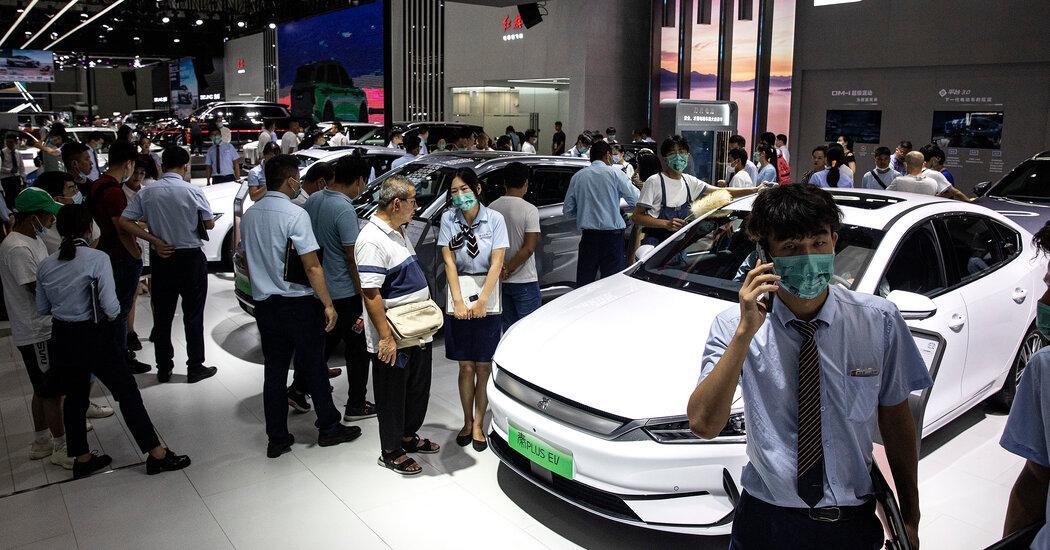Zhang Youping, a Chinese retiree, purchased an all-electric, small sport-utility vehicle from BYD — China’s largest electric vehicle maker — at an auto show for around $20,000 last month. Her family has bought three gas-powered cars in the last decade, but she recently grew concerned about gas prices and decided to go electric “to save money.” A few months earlier, her son had also bought an E.V. It was a $10,000 hatchback from Leapmotor, another Chinese manufacturer. This year, a quarter of all new cars purchased in China will be…
Tag: Electric and Hybrid Vehicles
India’s Electric Vehicle Push Is Riding on Mopeds and Rickshaws
In the United States, luxury-car buyers are snapping up Teslas and other electric cars that cost more than $60,000, and even relatively cheap models cost more than $25,000. Here in India, those are all out of reach of the vast majority of families, whose median income is just $2,400. But an electric vehicle movement is taking place nonetheless, not on four wheels, but on two and three. Electric mopeds and three-wheeled rickshaw taxis that sell for as little as $1,000 are zipping along India’s congested urban thoroughfares, cheered on by…
Tesla’s Aura Dims as Its Plunging Stock Highlights the Risks It Faces
Chinese consumers “are edgy, they’re worried about the future,” Mr. Dunne said. “It’s a double whammy that Tesla confronts in China.” Tesla shares are reacting in part to the same forces that are roiling stock markets around the world: war in Ukraine, rising interest rates, the threat of recession, supply chain chaos and surging inflation. But Tesla shares have fallen much more than other Silicon Valley giants like Apple or Alphabet, the company that owns Google. Tesla accounted for three-quarters of the electric cars sold in the United States last…
Biden Administration Begins $3 Billion Plan for Electric Car Batteries
The Biden administration plans to begin a $3.1 billion effort on Monday to spur the domestic production of advanced batteries, which are essential to its plan to speed the adoption of electric vehicles and renewable energy. President Biden has prodded automakers to churn out electric vehicles and utilities to switch to solar, wind and other clean energy, saying the transitions are critical to eliminating the pollution that is dangerously heating the planet. In the wake of surging energy prices caused largely by Russia’s invasion of Ukraine, administration officials also have…
Ukraine’s Russia Crisis Reveals the West’s False Sense of Energy Security
Russia’s belligerence against Ukraine is underscoring once again the inextricable link between national security and energy security. Today, Russia is flexing its energy dominance over a dependent Europe. But tomorrow, the danger may come from China and its control over the raw materials that are key to a clean energy future. The United States and its allies must ensure that doesn’t happen. In recent years America has been lulled into a false sense of energy independence. The shale revolution of the past decade has generated incredible supplies of vital natural…
For the Climate, Biden Must Be More Aggressive in Ending New Truck and Bus Emissions
At a gathering on the White House lawn last August, President Biden spoke of a future in which electric cars and trucks will be the only vehicles on the road. “The question,” he said, “is whether we’ll lead or fall behind” in the global race to achieve that vision. Mr. Biden has been vigorous in pushing for the end of the internal combustion engine for cars and light trucks. In August he signed an executive order that called on the federal government to do all it can to ensure that…
In Congo, Bolivia and Beyond, Where the Green Future Begins
Like prospectors in the American West during the gold rush, companies and self-starters are racing to far-flung places around the globe to mine the natural resources that will drive the technology of the 21st century. The Times’s ongoing Race to the Future series is documenting the geopolitical, economic and environmental wrangling that is shaping the shift from fossil fuels to electricity in vehicle technology. Times journalists from four desks are collaborating to shed light on the scramble for metals and the players involved: local residents with pickaxes, celebrity investors eyeing…
How China Makes Electric Car Batteries
How China Makes Electric Car Batteries Keith Bradsher📍Reporting from China From left: Qilai Shen/Bloomberg via Getty Images; Pool photo by Britta Pedersen CATL’s share price has soared. Robin Zeng, CATL’s chairman, is not as rich as Tesla’s Elon Musk, but his $60 billion fortune makes him one of the wealthiest people in Asia. NYT
How China’s CATL Became the Top Electric Car Battery Maker
CATL’s initial public offering in 2018 made Mr. Zeng and two CATL vice chairmen, who together own a 40 percent stake, rich. Other early investors, some with deep political connections, did well, too. The company’s success was never assured, but China had let the world know that it planned to dominate the electric vehicle industry. It said in a sweeping announcement in 2016 that a “third industrial revolution” focusing on digitization and “new energy” would allow China to take the lead in autos. CATL invited a few outside investors to…
How Tesla Helps China’s Firms Compete With the U.S.
Forty-two years ago, Liu Siong Song built machines to help factories make cheap toys and watches. Then he made them for motorcycle companies. Now he helps Tesla, in the words of Elon Musk, “make full-size cars in the same way that toy cars are made.” Mr. Liu, 69, may have come full circle, in a sense, but he also may play a role in the future of driving. His company is one of the emerging Chinese manufacturers competing aggressively and competently with traditional players in the United States, Japan and…






